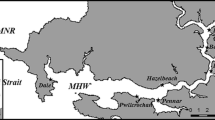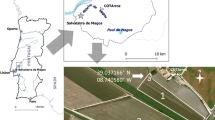Abstract
This study aimed to analyze the relationship between Cygnus spp. population trends and land-use changes and artificial development activities in the Nakdonggang Estuary for the necessity of management to the buffer area outside the protected area boundary in Korea. Analysis of the 15-year population change revealed a sharp decline in the Cygnus columbianus population in the winter, which could be attributed to the Nakdonggang Estuary becoming unfeasible as their wintering site. In contrast, there was no sharp decline in the Cygnus cygnus population, although a moderate decline was identified. Over the past 30 years, farmland activities decreased by approximately 10% in the areas adjacent to the protected area resulting from the expansion of the urbanized area. The rate of decrease in the water body area was high, attributed to urban development through reclamation. The correlation analysis between the area (ha) of paddy fields and the monthly (Nov.–Feb.) population of C. columbianus indicated that the populations in December (R2 = 0.768) and January (R2 = 0.743) were more correlated with the change in paddy field areas than those in the early winter (November: R2 = 0.457) and at the end of winter (February: R2 = 0.582). In the case of C. cygnus, the population tended to increase with increases in the areas of paddy fields, but the statistical explanatory power was low. We identified a distinct difference in that C. columbianus was more sensitive to urbanization than C. cygnus in the Nakdonggang Estuary.








Similar content being viewed by others
Data availability
The datasets generated in the current study are available from the corresponding author on reasonable request.
Abbreviations
- C. spp.:
-
Cygnus spp.
- C. cygnus :
-
Cygnus cygnus
- C. columbianus :
-
Cygnus columbianus
- EN:
-
Endangered
- LC:
-
Least concern
- VU:
-
Vulnerable
References
Blums P, Nichols JD, Hines JE, Mednis A (2002) Sources of variation in survival and breeding site fidelity in three species of European ducks. J Anim Ecol 71:438–450. https://doi.org/10.1046/j.1365-2656.2002.00613.x
Burton NH, Rehfisch MM, Clark NA, Dodd SG (2006) Impacts of sudden winter habitat loss on the body condition and survival of redshank Tringa totanus. J Appl Ecol 43:464–473. https://doi.org/10.1111/j.1365-2664.2006.01156.x
Chithra S, Senthil Kumar SRR, Chinnaraju K, Alfin Ashmita F (2016) A comparative study on the compressive strength prediction models for high performance concrete containing nano silica and copper slag using regression analysis and artificial neural networks. Constr Build Mater 114:528–535. https://doi.org/10.1016/j.conbuildmat.2016.03.214
Choi JE, Kim JY, Do YN, Joo GJ (2018) Population trends of wintering whooper swans (Cygnus cygnus) in South Korea: data from the winter waterbird census program. Korean J Ecol Environ 51:365–372. https://doi.org/10.11614/KSL.2018.51.4.365
Fujioka M, Lee SD, Kurechi M, Yoshida H (2010) Bird use of rice fields in Korea and Japan. Waterbirds 33:8–29. https://doi.org/10.1675/063.033.s102
Hahm KH, Kim TJ (2001) Population fluctuations of Cygnus cygnus and C. columbianus during 11 years, on Junam reservoir of Kyungsannam-do (1989–1999). Korean J Ornithol 8:47–53
Hong SH (2020) Relationship between population of wintering whopper swan (Cygnus cygnus) and bridge spacing in the lower Nakdong River, Korea. Korean J Environ Ecol 34:191–197. https://doi.org/10.13047/KJEE.2020.34.3.191
Inger R, Harrison XA, Ruxton GD, Newton J, Colhoun K, Gudmundsson GA, McElwaine G, Pickford M, Hodgson D, Bearhop S (2010) Carry-over effects reveal reproductive costs in a long-distance migrant. J Anim Ecol 79:974–982. https://doi.org/10.1111/j.1365-2656.2010.01712.x
Jinming L, Wang Y, Yang F, Liu Z (2012) Effects of human disturbance on the Hooded Crane (Grus monacha) at stopover sites in northeastern China. Chin Birds 3:206–216. https://doi.org/10.5122/cbirds.2012.0024
Kang JH, Kim JK, Yoo SH, Kang TH, Paek WK (2008) Current status and distribution of the natural monument bird species in Korea. Korean J Ornithol 15:73–84
Kim HC, Won PO (1994) Ecology of waterbirds on the Naktong River Estuary, Korea. Korean J Ornithol 1:57–71
Kim GY, Lee CW, Yoon HS, Joo GJ (2005) Changes of distribution of vascular hydrophytes in the Nakdong River Estuary and growth dynamics of Schenoplectus triqueter, waterfowl food plant. Korean J Ecol 28:335–345. https://doi.org/10.5141/JEFB.2005.28.5.335
Kim HN, Lee JW, Yoo JC (2017) Population fluctuation of wintering great cormorants (Phalacrocorax carbo) andits potential impact in Hangang. Korean J Ornithol 24(2):25–40
Kim DW, Kim JS, Kim MK (2018) Application of relative favorability function model for land-use and land-cover change (LUCC) prediction in South Korea. J Assoc Korean Geogr 7:463–478
Lameris TK, Scholten I, Bauer S, Cobben MMP, Ens BJ, Nolet BA (2017) Potential for an Arctic-breeding migratory bird to adjust spring migration phenology to Arctic amplification. Glob Change Biol 23:4058–4067. https://doi.org/10.1111/gcb.13684
Meng F, Chen L, Fang L, Zhang B, Li C, Zhao G, Batbayar N, Natsagdorj T, Damba I, Liu S, Wood KA, Cao L, Fox AD (2020) The migratory mute swan Cygnus olor population in East Asia. Wildfowl Spl 6:73–96
Ministry of Environment (2020) https://egis.me.go.kr/main.do
National Institute of Biological Resources (2020) https://species.nibr.go.kr/bird/home/geo/index.do
Nuijten RJ, Wood KA, Haitjema T, Rees EC, Nolet BA (2020) Concurrent shifts in wintering distribution and phenology in migratory swans: individual and generational effects. Glob Change Biol 26:4263–4275. https://doi.org/10.1111/gcb.15151
Powell JA, Engelhardt KA (2000) Optimal trajectories for the short-distance foraging flights of swans. J Theor Biol 204:415–430. https://doi.org/10.1006/jtbi.2000.2026
Ramsar Convention on Wetlands (2018) Global wetland outlook: state of the world’s wetlands and their services to people. Ramsar Convention Secretariat, Gland
Rees EC, Cao L, Clausen P, Coleman JT, Cornely J, Einarsson O, Ely CR, Kingsford RT, Ma M, Mitchell CD, Nagy S, Shimada T, Snyder J, Solovyeva DV, Tijsen W, Vilina YA, Włodarczyk R, Brides K (2019) Conservation status of the world’s swan populations, Cygnus sp. and Coscoroba sp.: a review of current trends and gaps in knowledge. Wildfowl 5:35–72
Robertson G, Cooke F (1999) Winter philopatry in migratory water-fowl. Auk 116:20–34. https://doi.org/10.2307/4089450
Shimada T, Yamaguchi NM, Hijikata N, Hiraoka E, Hupp JW, Flint PL, Tokita K, Fujita G, Uchida K, Uchida K, Sato F, Kurechi M, Pearce JM, Ramey AM, Higuchi H (2014) Satellite tracking of migrating Whooper Swans Cygnus cygnus wintering in Japan. Ornithol Sci 13:67–75. https://doi.org/10.2326/osj.13.67
Stillman RA, Wood KA, Gilkerson W, Elkinton E, Black JM, Ward DH, Petrie M (2015) Predicting effects of environmental change on a migratory herbivore. Ecosphere 6(7):1–19. https://doi.org/10.1890/ES14-00455.1
Van Gils JA, Tijsen W (2007) Short-term foraging costs and long-term fueling rates in central-place foraging swans revealed by giving-up exploitation times. Am Nat 169:609–620. https://doi.org/10.1086/513114
Wang X, Yang E, Zhou L (2021) Wintering behavior of Tundra Swan, Cygnus columbianus, at a small water-level controlled lake in the middle and lower Yangtze River Floodplain. Pak J Zool 53:1501–1507. https://doi.org/10.17582/journal.pjz/20200305030310
Watanabe T, Watanabe H, Yamamoto A, Shimizu Y (2008) The importance of Zizania latifolia as food for geese and swans at inland waters and differences in foraging methods among species. Jpn J Ornithol 57:97–107. https://doi.org/10.3838/jjo.57.97
Weathers WW, Buttermer WA, Hayworth AM, Nagy KA (1984) An evaluation of time-budget estimates of daily energy expenditure in birds. Auk 101:459–472. https://doi.org/10.1093/auk/101.3.459
Wood KA, Newth JL, Brides K, Burdekin M, Harrison AL, Heaven S, Kitchin C, Marshall L, Mitchell C, Jessica P, Scott DK, Smith J, Tijsen W, Hilton GM, Rees EC (2019) Are long-term trends in Bewick’s Swan Cygnus columbianus bewickii numbers driven by changes in winter food resources? Bird Conserv Int 29:479–496. https://doi.org/10.1017/S0959270918000382
Wood KA, Newth JL, Hilton GM, Rees EC (2021) Behavioural and energetic consequences of competition among three overwintering swan (Cygnus spp.) species. Avian Res 12:1–15. https://doi.org/10.1186/s40657-021-00282-5
Acknowledgements
The authors thank WETLANDS & BIRDS KOREA (NGO) for providing the research materials for this research and their efforts in the conservation of Nakdonggang Estuary. They would also like to thank Editage (www.editage.co.kr) for English language editing and the reviewers for their comments that improved this manuscript.
Funding
The authors have no relevant financial or non-financial interests to disclose.
Author information
Authors and Affiliations
Contributions
All authors contributed to the study conception and design. Material preparation, data collection, and analysis were mainly conducted by S-HH and J-HY, and supported by S-HK and J-LP.
Corresponding author
Ethics declarations
Competing interests
The authors declare no competing interests.
Additional information
Publisher's Note
Springer Nature remains neutral with regard to jurisdictional claims in published maps and institutional affiliations.
Rights and permissions
Springer Nature or its licensor (e.g. a society or other partner) holds exclusive rights to this article under a publishing agreement with the author(s) or other rightsholder(s); author self-archiving of the accepted manuscript version of this article is solely governed by the terms of such publishing agreement and applicable law.
About this article
Cite this article
Hong, SH., Yeum, JH., Kim, SH. et al. Decrease in population of swans (Cygnus spp.) due to the development of areas adjacent to the wintering site. Wetlands Ecol Manage 31, 177–190 (2023). https://doi.org/10.1007/s11273-023-09909-4
Received:
Accepted:
Published:
Issue Date:
DOI: https://doi.org/10.1007/s11273-023-09909-4




